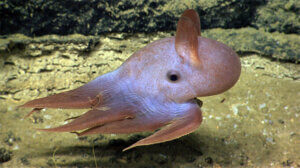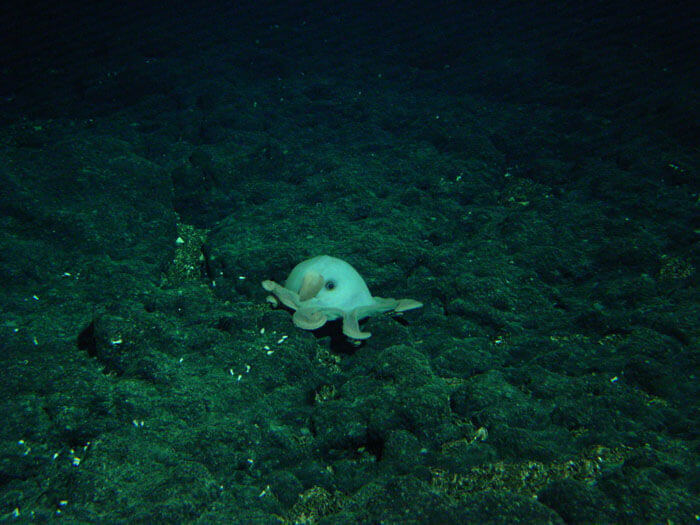The Dumbo Octopus, Curious but Little Known

The dumbo octopus is unique in its family, as it propels itself in a way that distinguishes it from other octopuses. Its habitat is also very different and makes it almost a complete mystery to humans. In this article, we invite you to discover this special octopus.
The characteristics of the dumbo octopus
The great characteristic that defines the dumbo octopus is its appearance. Although all other octopuses have long tentacles and propel themselves by expelling water, this animal has two fins on the sides of its head that help it swim. These two fins are ear-like. In fact, the name “dumbo” comes from its resemblance to the main character of the 1941 Disney film, Dumbo, who flew with its ears.
The dumbo octopus isn’t a single species. Instead, it’s a genus made up of at least 13 different species to date. They all have webbed tentacles and fins on their heads. Also, all species swallow their prey whole instead of breaking them down before putting them in their mouths, as other cephalopods do.
The dumbo octopus lives in the depths of the ocean. As this is such an inaccessible place, experts know very little about it. They don’t even know what the average size of the species is, and only recently were they able to observe their offspring. In addition, experts still don’t know how they reproduce.

In general, they’ve been observed to be white or very pale in color. The lack of light in their habitat doesn’t make it necessary for them to develop skin pigments. The dumbo octopus has a very gelatinous body, which helps it to withstand the great environmental pressure it’s subjected to throughout its life.
The size and mean weight of the species are two other unknowns. The biggest recorded specimen weighed almost 28 pounds and was almost six feet long, but the rest of the octopuses that have been observed are much smaller. The average size is estimated to be 11.8 inches, and experts don’t know how heavy specimens of that size would be.
Behavior of the dumbo octopus
Experts know even less about their behavior than they do about their characteristics. The only thing they do know is that they live at great depths and that they propel themselves with the two fins they have on their heads.
Experts know that their diet roughly consists of crustaceans, bivalves, and worms. While they propel themselves and keep their balance with their fins, they feel the sea floor, rocks, or coral with their fins to find prey. They place their prey on top of them and swallow them whole.
It seems that this species has no breeding season. The females carry several eggs in different stages of maturation inside them and, when environmental conditions are favorable, they fertilize one of them and deposit it. The young are born fully developed, meaning they can fend for themselves.
The habitat of the dumbo octopus
The dumbo octopus is the deepest living octopus species. In fact, they’ve been found at depths of between 6,500 and 16,400 feet. At that depth, sunlight no longer penetrates the ocean and there’s great atmospheric pressure.

Experts believe that they inhabit the entire planet. In fact, they’ve been found on the Pacific and Atlantic coasts of North America, in the islands of the Philippines, in the Azores Islands, New Zealand, Australia, and New Guinea. Thus, they don’t seem to prefer a specific ocean.
Conservation of the dumbo octopus
Because they live at such depths in the ocean, humans can’t threaten their survival. The great threats to this species are climate change and rising sea surface temperatures, as well as marine pollution. The latter is due to the fact that pieces of garbage or other types of debris can descend into their habitat.
The health of the octocorals, where the females lay their eggs, seem essential for their survival as well. Without these corals, the dumbo octopus can’t reproduce and the young can’t hunt their first prey to survive and grow.
Nevertheless, they have to protect themselves from certain predators, such as killer whales, sharks, other bigger cephalopods, and even tuna.
Of all the octopus species, the dumbo octopus inhabits the deepest parts of the oceans. This allows it to survive and develop without human threats. However, this has made it harder for experts to study it better.
The dumbo octopus is unique in its family, as it propels itself in a way that distinguishes it from other octopuses. Its habitat is also very different and makes it almost a complete mystery to humans. In this article, we invite you to discover this special octopus.
The characteristics of the dumbo octopus
The great characteristic that defines the dumbo octopus is its appearance. Although all other octopuses have long tentacles and propel themselves by expelling water, this animal has two fins on the sides of its head that help it swim. These two fins are ear-like. In fact, the name “dumbo” comes from its resemblance to the main character of the 1941 Disney film, Dumbo, who flew with its ears.
The dumbo octopus isn’t a single species. Instead, it’s a genus made up of at least 13 different species to date. They all have webbed tentacles and fins on their heads. Also, all species swallow their prey whole instead of breaking them down before putting them in their mouths, as other cephalopods do.
The dumbo octopus lives in the depths of the ocean. As this is such an inaccessible place, experts know very little about it. They don’t even know what the average size of the species is, and only recently were they able to observe their offspring. In addition, experts still don’t know how they reproduce.

In general, they’ve been observed to be white or very pale in color. The lack of light in their habitat doesn’t make it necessary for them to develop skin pigments. The dumbo octopus has a very gelatinous body, which helps it to withstand the great environmental pressure it’s subjected to throughout its life.
The size and mean weight of the species are two other unknowns. The biggest recorded specimen weighed almost 28 pounds and was almost six feet long, but the rest of the octopuses that have been observed are much smaller. The average size is estimated to be 11.8 inches, and experts don’t know how heavy specimens of that size would be.
Behavior of the dumbo octopus
Experts know even less about their behavior than they do about their characteristics. The only thing they do know is that they live at great depths and that they propel themselves with the two fins they have on their heads.
Experts know that their diet roughly consists of crustaceans, bivalves, and worms. While they propel themselves and keep their balance with their fins, they feel the sea floor, rocks, or coral with their fins to find prey. They place their prey on top of them and swallow them whole.
It seems that this species has no breeding season. The females carry several eggs in different stages of maturation inside them and, when environmental conditions are favorable, they fertilize one of them and deposit it. The young are born fully developed, meaning they can fend for themselves.
The habitat of the dumbo octopus
The dumbo octopus is the deepest living octopus species. In fact, they’ve been found at depths of between 6,500 and 16,400 feet. At that depth, sunlight no longer penetrates the ocean and there’s great atmospheric pressure.

Experts believe that they inhabit the entire planet. In fact, they’ve been found on the Pacific and Atlantic coasts of North America, in the islands of the Philippines, in the Azores Islands, New Zealand, Australia, and New Guinea. Thus, they don’t seem to prefer a specific ocean.
Conservation of the dumbo octopus
Because they live at such depths in the ocean, humans can’t threaten their survival. The great threats to this species are climate change and rising sea surface temperatures, as well as marine pollution. The latter is due to the fact that pieces of garbage or other types of debris can descend into their habitat.
The health of the octocorals, where the females lay their eggs, seem essential for their survival as well. Without these corals, the dumbo octopus can’t reproduce and the young can’t hunt their first prey to survive and grow.
Nevertheless, they have to protect themselves from certain predators, such as killer whales, sharks, other bigger cephalopods, and even tuna.
Of all the octopus species, the dumbo octopus inhabits the deepest parts of the oceans. This allows it to survive and develop without human threats. However, this has made it harder for experts to study it better.
This text is provided for informational purposes only and does not replace consultation with a professional. If in doubt, consult your specialist.








